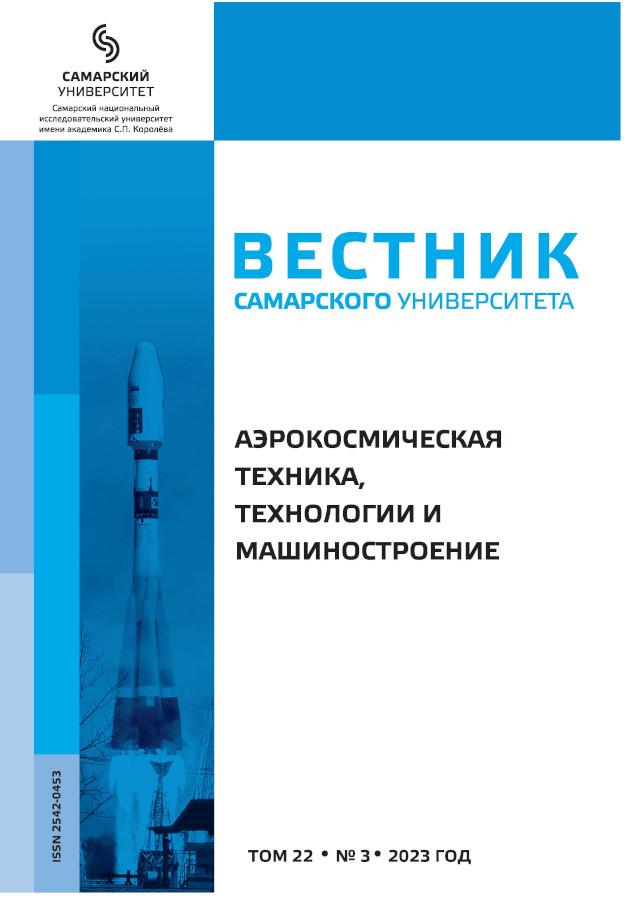Study of the efficiency of the application of gas dynamic stabilization of the flame in a current engine
- Authors: Belonozhkin V.V.1, Teslya D.N.1
-
Affiliations:
- Military Educational and Scientific Center of the Air Force Academy named after Professor N.E. Zhukovsky and Yu.A. Gagarin
- Issue: Vol 22, No 3 (2023)
- Pages: 7-12
- Section: AIRCRAFT AND SPACE ROCKET ENGINEERING
- URL: https://journals.ssau.ru/vestnik/article/view/26884
- DOI: https://doi.org/10.18287/2541-7533-2023-22-3-7-12
- ID: 26884
Cite item
Full Text
Abstract
An analysis of the problems that arise when dealing with issues of increasing the efficiency of using an afterburner as part of a current aircraft engine is presented, where the complex problem of reducing its influence in non-afterburning operation and improving the work process when using it is solved. In a number of cases, solving the problem comes down to a compromise which does not allow full realization of all the advantages of the design element in question. The results of a study of the influence of the method of gas-dynamic flame stabilization on the main target indicator – specific fuel consumption in a real engine are presented, which makes it possible to justify conducting this kind of research on a real object. Graphs of changes in specific fuel consumption and thrust of a gas turbine engine when changing the engine rotor speed for non-afterburning operating modes are presented, as well as graphs of changes in specific fuel consumption and thrust of a gas turbine engine when changing the speed of the aircraft for afterburning operating modes. A conclusion is drawn about the expedience of using gas-dynamic flame stabilization in the afterburner from the point of view of its effect on specific fuel consumption.
About the authors
V. V. Belonozhkin
Military Educational and Scientific Center of the Air Force Academy named after Professor N.E. Zhukovsky and Yu.A. Gagarin
Author for correspondence.
Email: belonozhkinvv@mail.ru
Associate Professor
Russian FederationD. N. Teslya
Military Educational and Scientific Center of the Air Force Academy named after Professor N.E. Zhukovsky and Yu.A. Gagarin
Email: patmi@rambler.ru
Senior Lecturer
Russian FederationReferences
- Kudryavtsev A.V., Medvedev V.V. Forsazhnye kamery i kamery sgoraniya PVRD. Inzhenernye metodiki rascheta kharakteristik [Ramjet engine afterburners and combustion chambers. Engineering practices of performance calculation]. Moscow: Central Institute of Aviation Motors Publ., 2013. 113 p.
- Pakhol'chenko A.A., Cherkasov A.N., Alekseev A.A., Koren' G.P., Moskaev V.A. Teoriya aviatsionnykh dvigateley: funktsional'nye elementy seriynykh silovykh ustanovok: uchebnoe posobie [Theory of aircraft engines: functional units of production power plants: Tutorial]. Voronezh: Voenno-vozdushnaya Akademiya Publ., 2015. 231 p.
- Nechaev Yu.N., Fedorov R.M., Kotovskiy V.N., Polev A.S. Teoriya aviatsionnykh dvigateley. Ch. 1 [Theory of aircraft engines. Part 1]. Moscow: Voenno-vozdushnaya Inzhenernaya Akademiya imeni N.E. Zhu-kovskogo Publ., 2006. 365 p.
- Evdokimov A.I., Kotsyubinskiy S.V., Frolov V.B., Gorskiy A.N., Titov D.V. Konstruktsiya i prochnost' aviadvigateley [Aircraft engine design and strength]. Moscow: Voenno-vozdushnaya Inzhenernaya Akademiya imeni N.E. Zhukovskogo Publ., 2007. 339 p.
- Mingazov B.G. Kamery sgoraniya gazoturbinnykh dvigateley: konstruktsiya, mod-elirovanie protsessov i raschet: uchebnoe posobie [Combustion chambers of gas turbine engines. Design, simulation and calculation: Tutorial]. Kazan: Kazan National Research Technical University Publ., 2006. 219 p.
Supplementary files






















